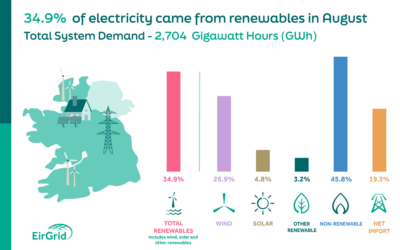
The total amount of grid-scale solar energy produced in 2024 was surpassed five months early in July of this year, EirGrid has confirmed.
Official metered data shows that by the end of July this year, 753 Gigawatt hours (GWh) of solar energy had been supplied on the grid, up from a total of 659 GWh for the whole of 2024.
EirGrid’s National Control Centre carries out the complex task of balancing the supply of solar energy alongside conventional generation sources and other renewable resources such as wind power to ensure that demand can be met.
The new yearly record comes against the backdrop of a series of solar activity peak records set over the course of the summer, with the highest level of 798 Megawatts (MW) recorded at 3 pm on Wednesday, 9 July.
Megawatt (MW) values provide snapshots of electricity demand at a particular moment in time, whereas Gigawatt Hours (GWh) reflects electricity use over a longer period.
Meanwhile, the latest provisional data from EirGrid shows that 35% of electricity came from renewables in August.
Overall, 27% of electricity in August came from wind, with 5% coming from solar. Gas was the single largest source of electricity generation for the month at 45%, with 19% coming from imports.
Overall electricity system demand stood at 2,704 GWh for August, down slightly from July.
Commenting on the data, Diarmaid Gillespie, Director of System Operations at EirGrid, said: “While the overall percentage for solar power remains relatively small compared to some other sources of generation, its strong growth has marked an evolution in Ireland’s fuel mix. This has been driven by progress in connecting large-scale solar energy to the national electricity grid in recent years.”
